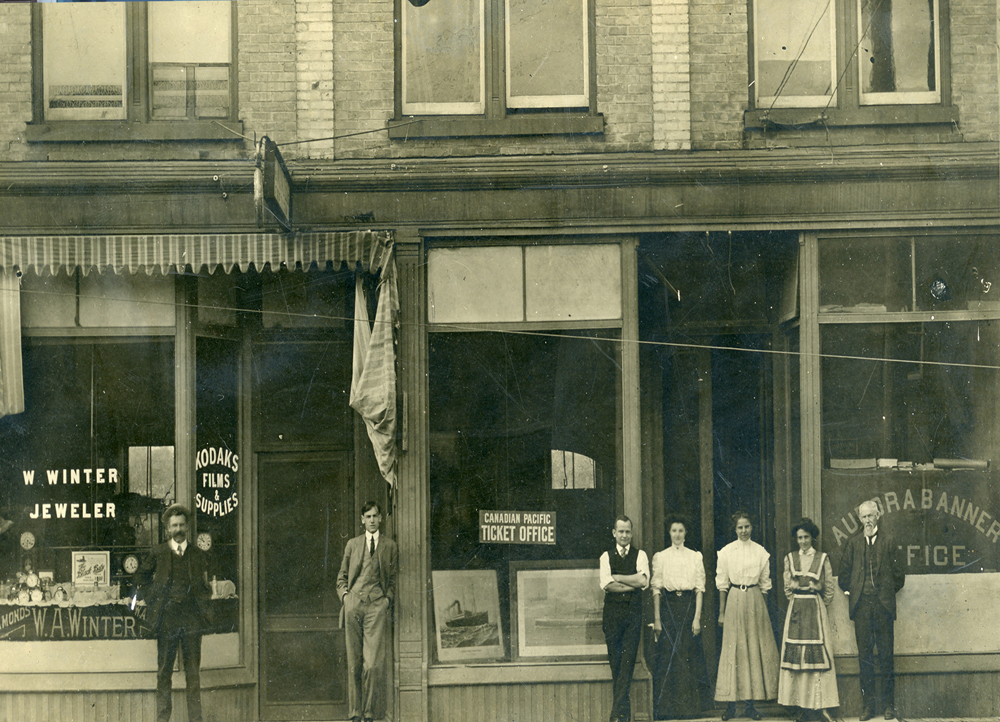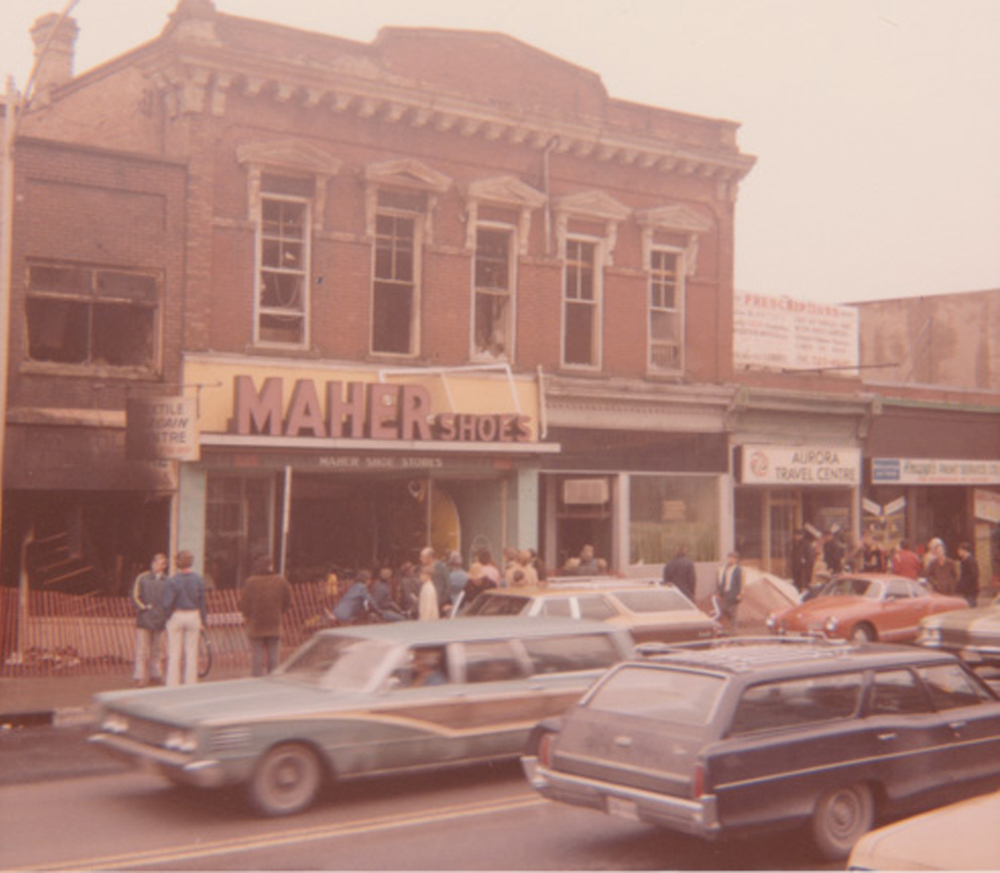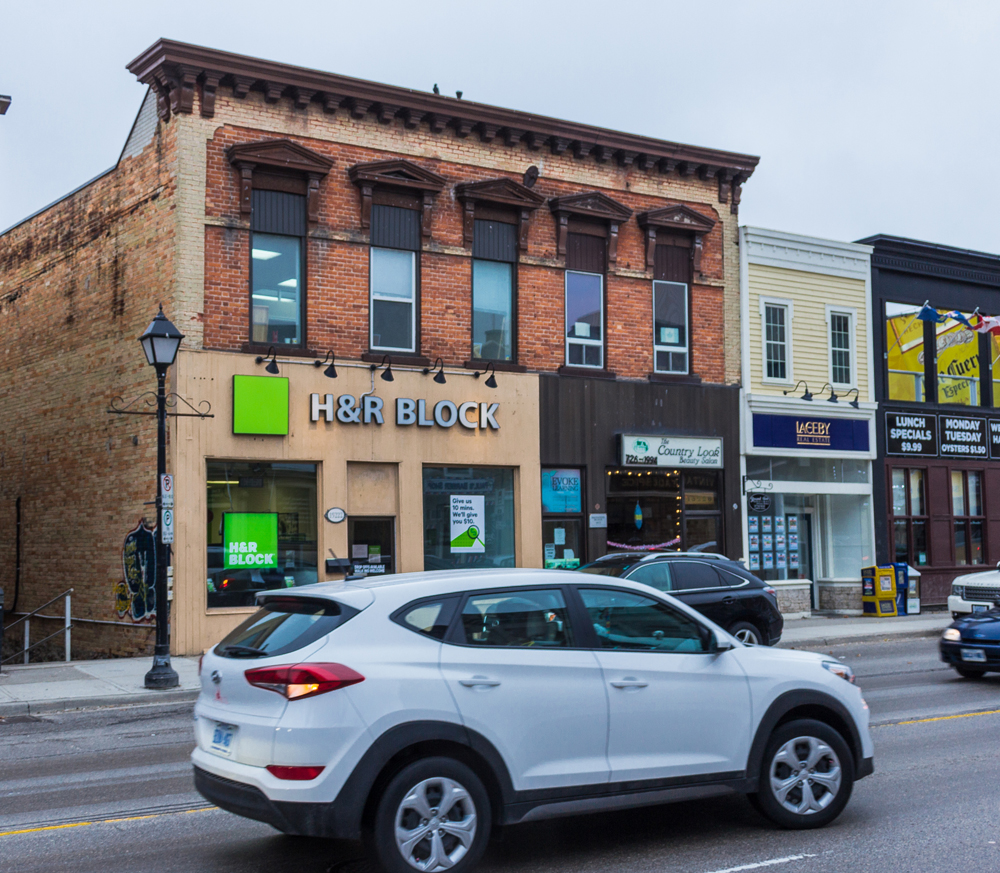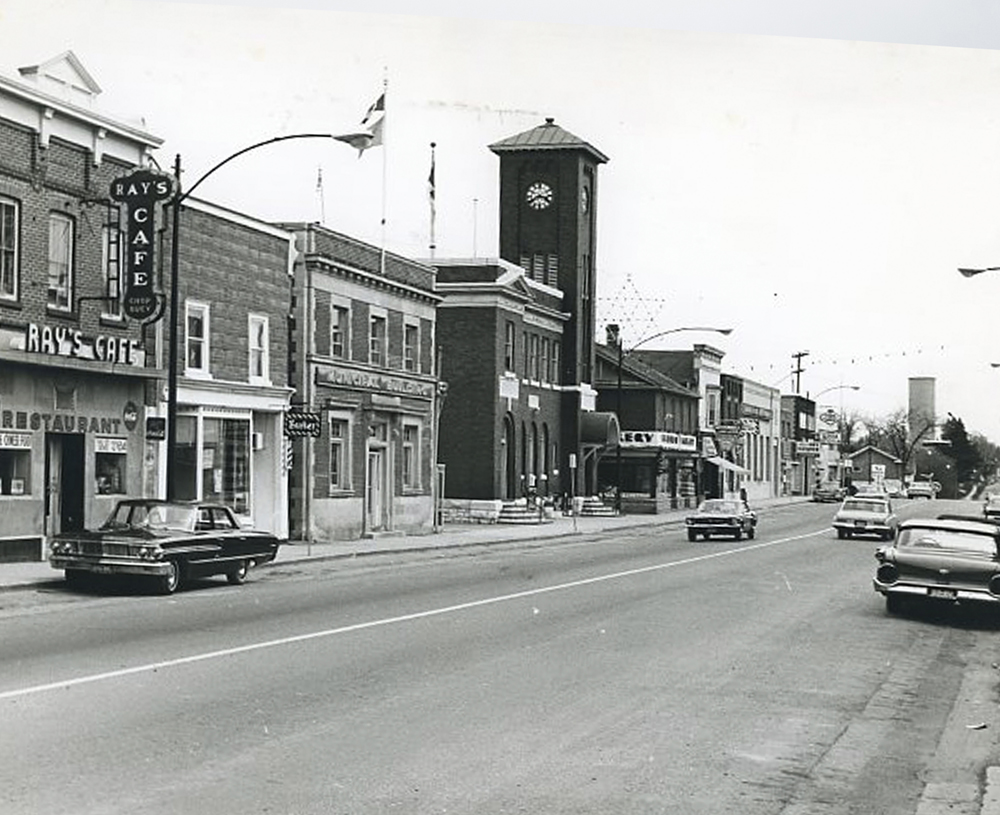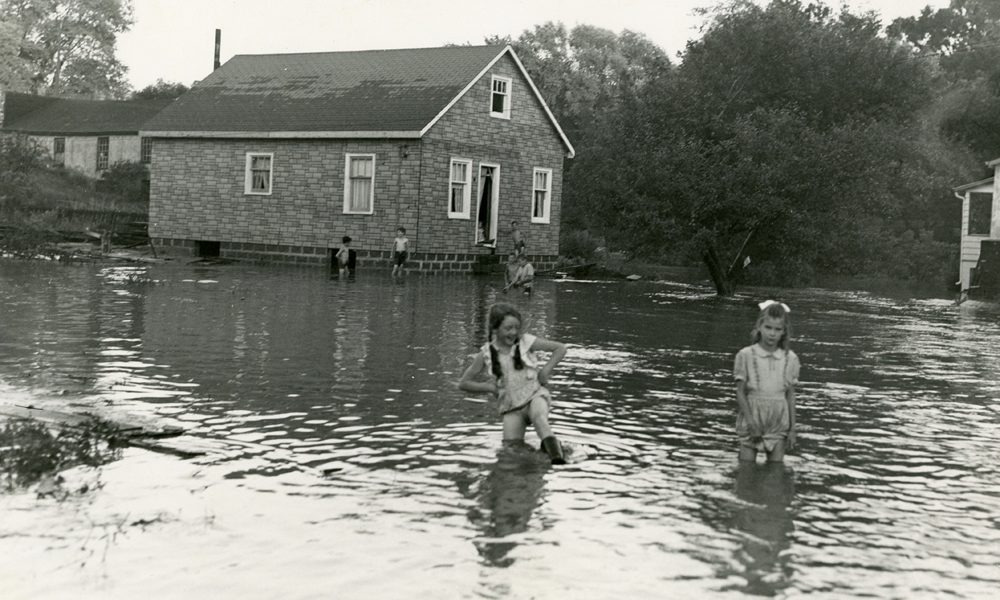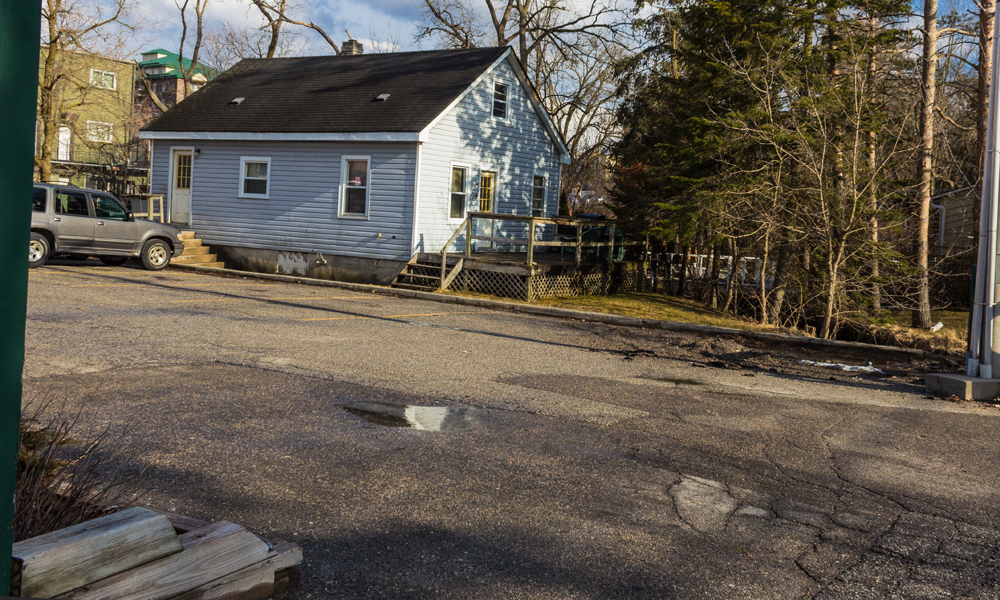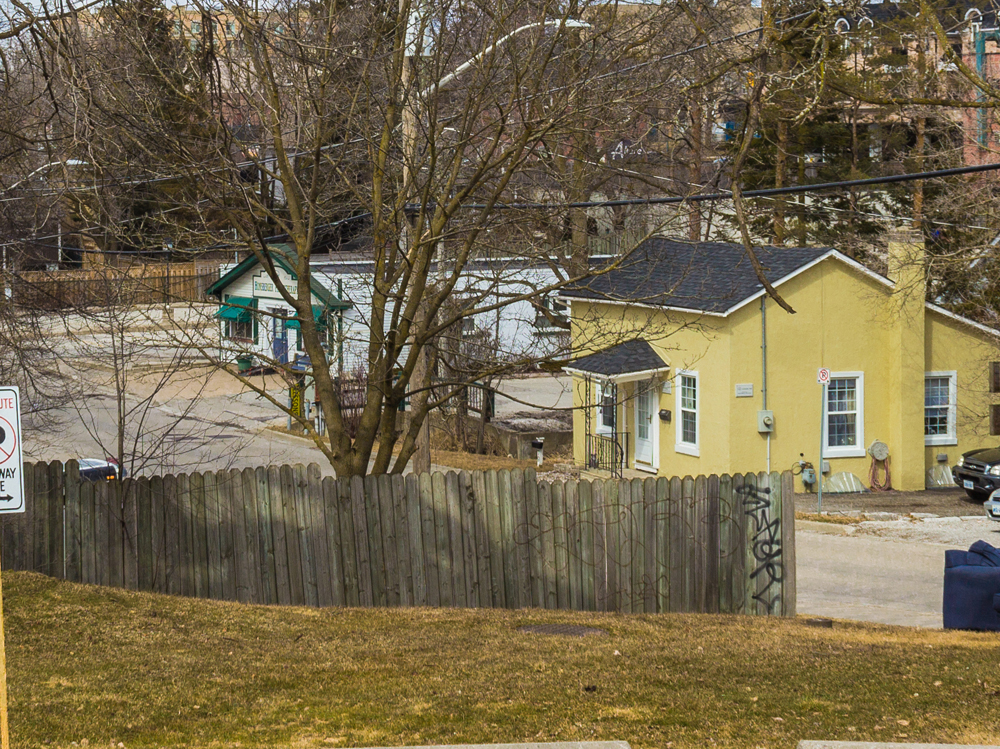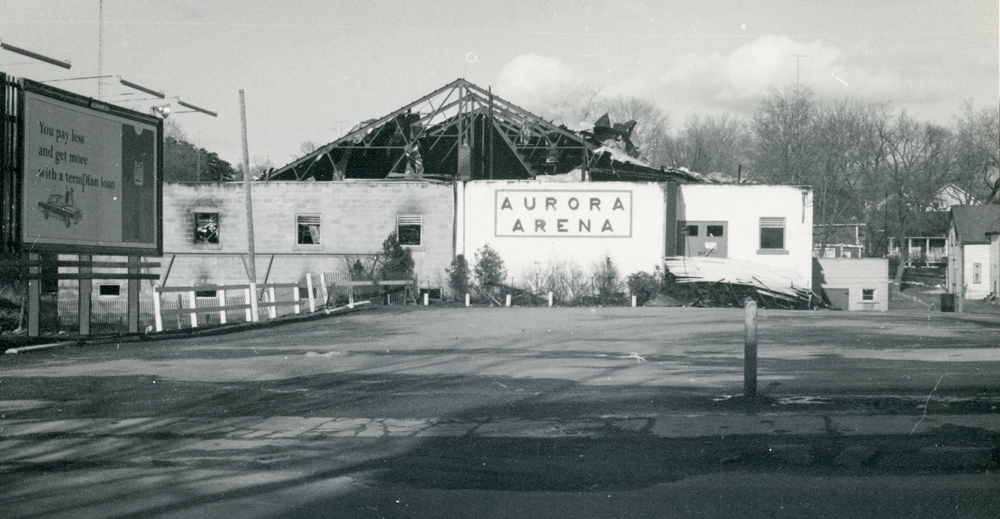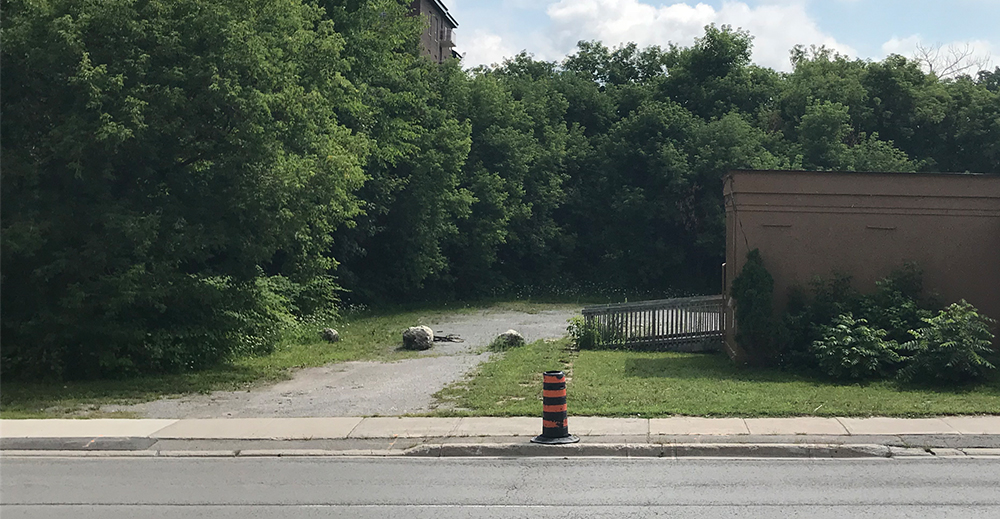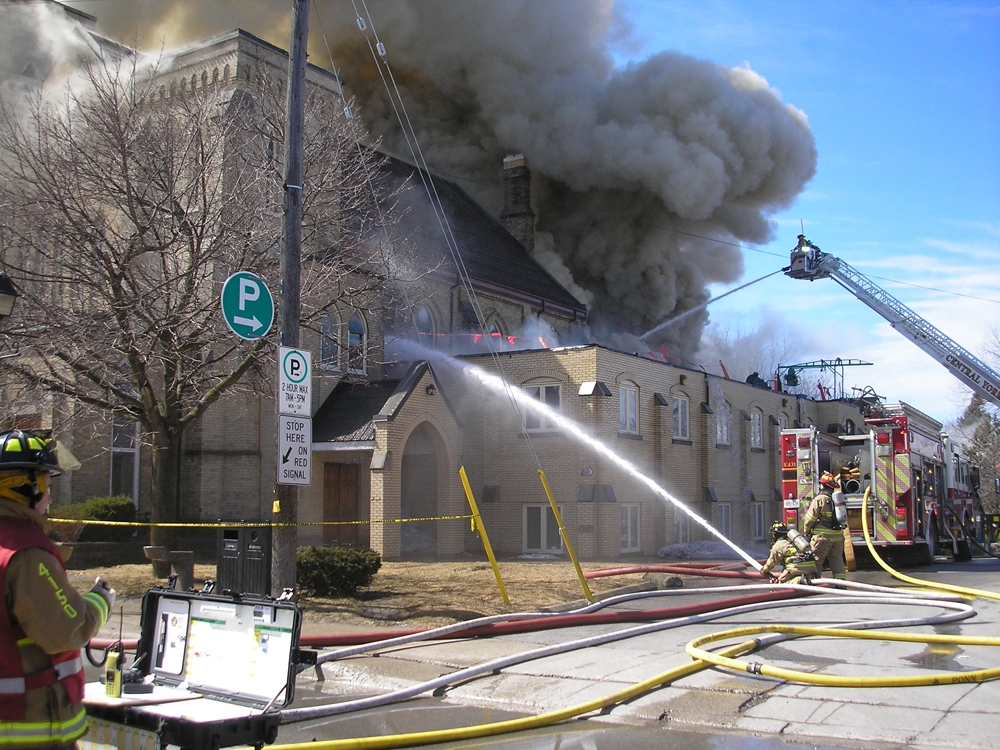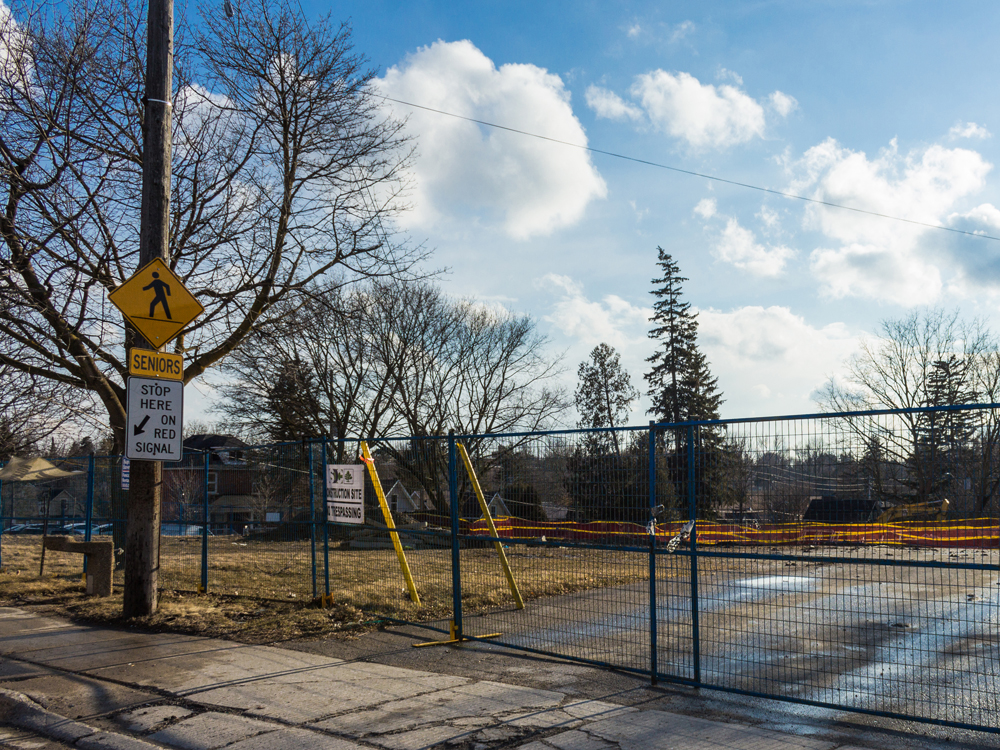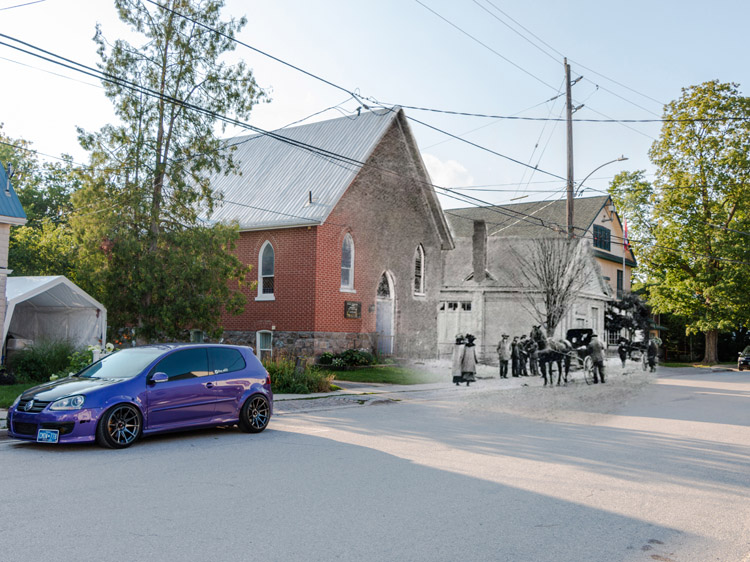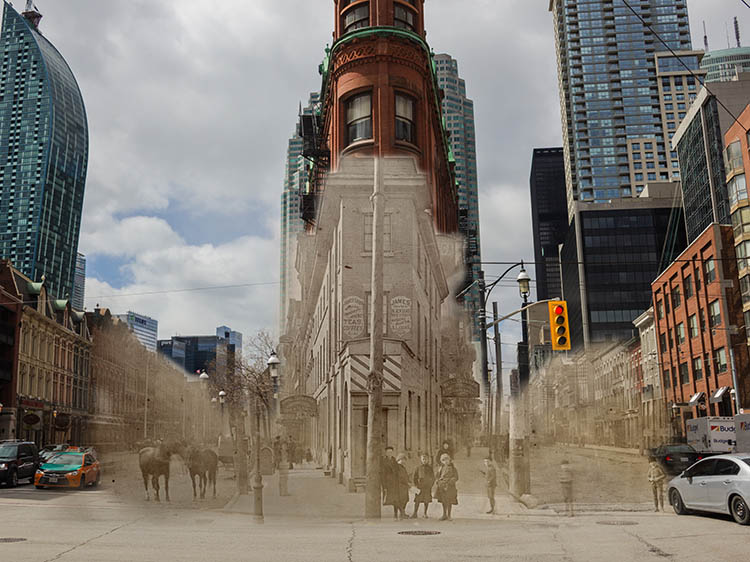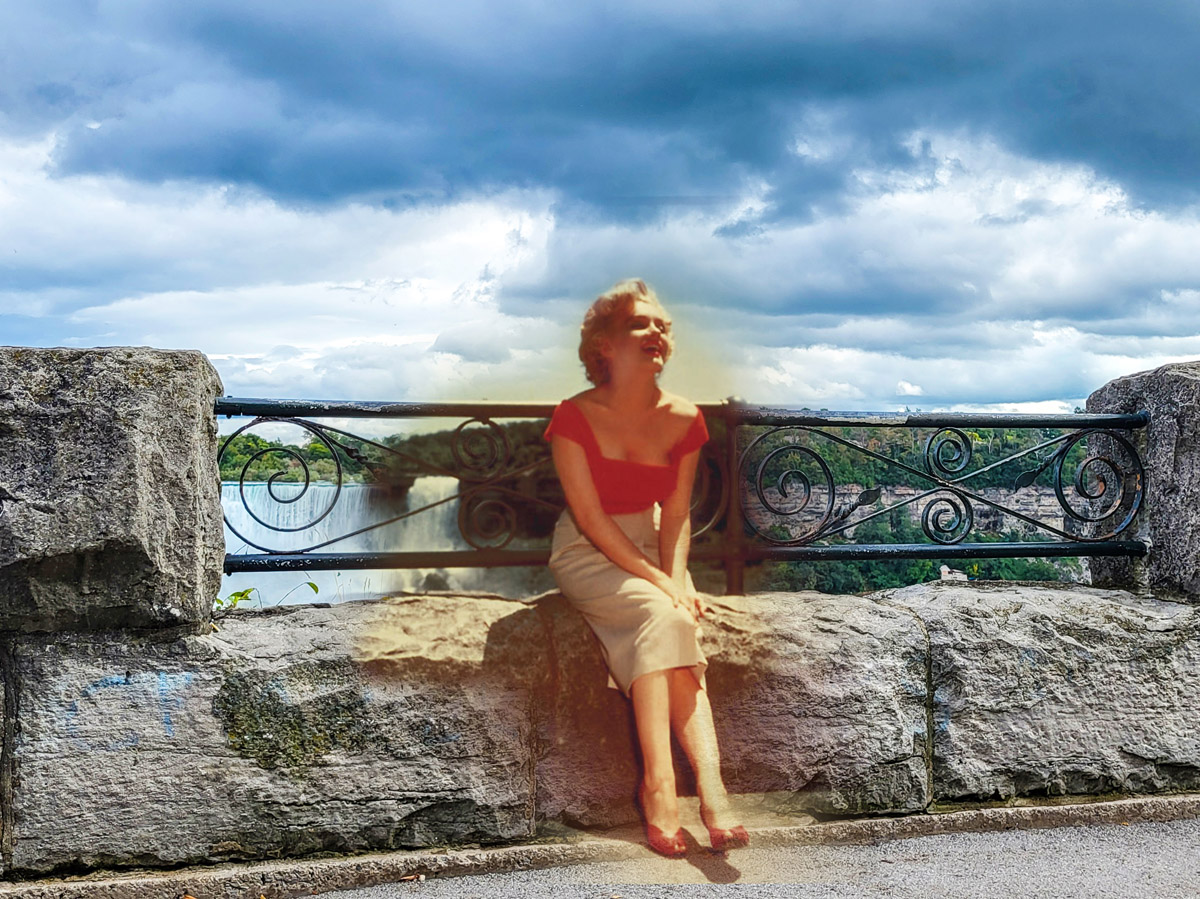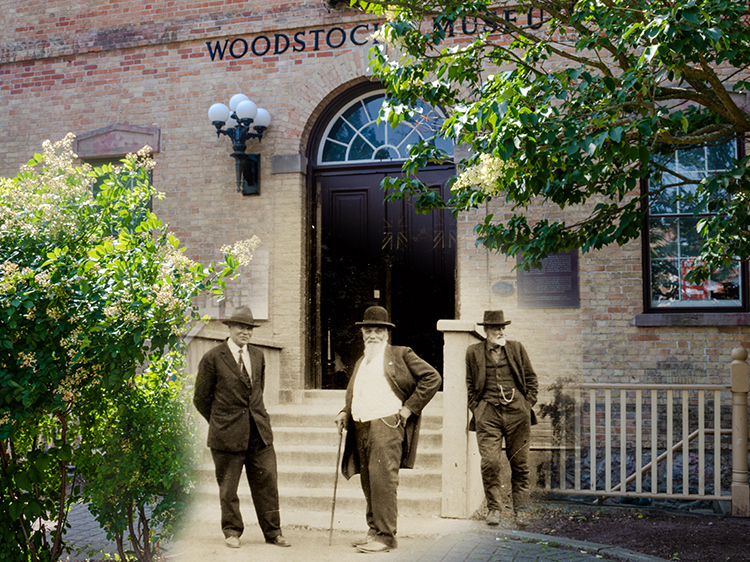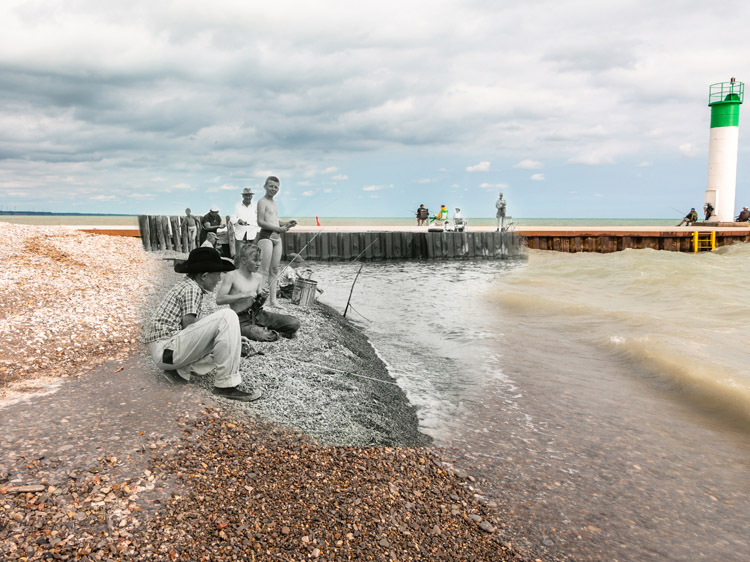Walking Tour
Fire, Wind, and Water
Disasters in Aurora History
Andrew Farris, Shawna White, Michelle Johnson
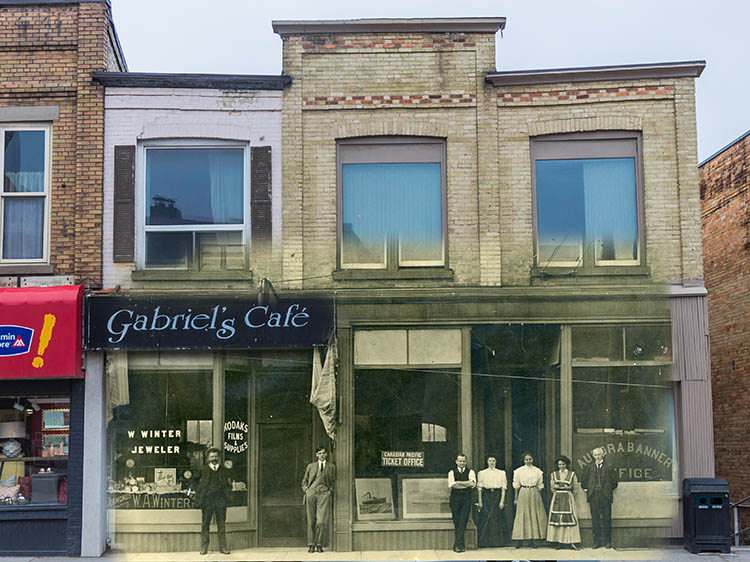
Over its history Aurora has had its fair share of disasters. There have been floods and cyclones, and most of all fires--many fires. These have devastated parts of the community time and again, yet through it all Aurorans have banded together to get through these trying times and rebuild in the aftermath. Through it all reporters for the Aurora Banner, and later the Auroran, watched and recorded these events, offering us fascinating insights into the ways Aurorans coped.
This tour examines the catastrophes that have befallen Aurora over the past 130 years, and uses historic photographs and contemporary articles from the Aurora Banner to discover how these events appeared to people at the time.
This project is a partnership with the Aurora Museum & Archives and the Town of Aurora.
1. The Great Fire of 1887
1900s
On the morning of March 20, 1887 it was here that a fire kindled into life, devastating many of the businesses on Yonge Street. As smoke began to billow from the wooden building that once stood on this spot, a quick-thinking passerby ran to the Town Hall and began ringing the bell to summon Aurora's volunteer firefighters.
The firefighters wasted no time, bringing their primitive hand-pumped engine to the site and battling the blaze. They could not, however, bring it under control before the flames had marched up the west side of Yonge Street, almost to Wellington, devouring seven businesses and three homes. Fortunately, there were no casualties.
Fast-moving fires have been a recurring event in Aurora's history, and the city's early wooden buildings were especially vulnerable to the flames: there were also large fires in 1859 and 1863. The enormous damage of this fire, however, caused the people of Aurora to take real action.
A bylaw was quickly passed that meant all new buildings on Yonge had to be brick, and many of the buildings you see around you today are the result. A municipal waterworks was built the next year, and water tanks placed around the town to aid any firefighters in the future.
* * *
"The most disastrous fire with which this place has ever been visited within our memory broke out in the rear of Mr. James Andrews block of buildings on Yonge Street, on Sunday morning last at about 9:30."
"The alarm was given and was promptly responded to by the Fire Brigade and a large number of our citizens. As soon as possible a stream of water from the engine was brought to bear on the burning buildings, but it was evident the fire had gained such headway - the buildings being all wood - that it would be impossible to save them, and the attention of the firemen was directed to prevent the fire spreading to the adjacent buildings.
"At one time it was feared the fire would spread to the east side of Yonge street. In the situation it was thought advisable to send to Newmarket for assistance. Accordingly a messenger was sent to Newmarket, and in a very short time an engine and hose-reel from their were on hind. Fortunately, however, the was pretty well under control by the time of their arrival.
"Albert Lloyd had a very narrow escape from being killed at the Todd block. He was up a ladder in front of the building, when the cry was raised that the wall was falling. With great presence of mind he turned around and slid down the ladder on his back, and scrambled out of the way just in time to escape being buried in the ruins."
"Unfortunately there was very little insurance on any of the property destroyed. The total loss over and above insurance will amount to about $110,000." 1
2. The Dangers of Firefighting
1972
The great fire of 1887 would not be the last one to wreak havoc on Yonge Street. This photo shows the aftermath of yet another one. In 1972 the Textile Bargain Centre once occupied the narrow alley to the left of the large building in front of you. It was a fire waiting to happen. To squeeze another business into the block, walls had been put at the front and back of the alley to enclose it and create an extremely narrow building. The windows in the walls of the brick buildings on either side had been boarded up, and the place filled with flammable fabrics.
On April 14, 1972, the dry clothes somehow caught fire and burst into flame. Aurora's firefighters were on the scene in minutes, dousing the flames and very nearly having the situation under control. Then the boards over the window on the north wall caught fire, spreading the fire next door to Maher's Shoes and bringing in a fresh supply of oxygen.
The volunteer firefighters fought valiantly to save the old building, and one firefighter was taken to hospital from smoke inhalation.
The Aurora Banner hailed the heroism of the firefighters, and marveled at the danger they exposed themselves to. In an editorial, the Banner also angrily decried the poor pay of the firefighters, who were asked to risk so much for a meager $8 a day.
* * *
"'Worth a little more than eight dollars,' one firefighter said following Friday night's dangerous blaze.
"For eight dollars.
"He was trying to save some lives, 'when a light fixture fell on him,' another said.
"For eight dollars.
"'They were up there on the second floor, crawling, trying to find the source of the blaze.'
"For eight dollars.
"Many didn't get to sleep, at all Friday night, and the ones who did managed 'an hour or so'.
"For eight dollars.
"They stuck their noses so far into that fire that many couldn't breathe. One went to the hospital because of it. They were on the scene or nearly for 10 hours.
"Maybe our sense of values is warped, but--it seems to us that--someone, somewhere has his priorities mixed up. These men literally put their lives on the line for eight bucks.
"Had it not been for his buddies, firefighter Joe DeGeer may never have come off that second floor alive.
"Asked what hit him, DeGeer replied that he had no idea. "It felt like the ceiling." After that, DeGeer's lights went out, and he was hauled to safety and taken to hospital. Luckily, his injuries were minor.
"We try to justify why a firefighter gets eight dollars a day while a regional councillor gets S6,000 a year for a part-time job. We wonder why our taxes will help pay for a million dollar provincial government jet, when the best the firefighters get is tiny.
"And we wonder what our municipality, and the region, would do if there were no volunteer firefighters who wanted to volunteer.
"We Keep wondering."1
3. Maintaining Civic Pride
Aurora Museum & Archives 2002.19.39
c. 1970s
The skill and bravery of Aurora's firefighters, and the effectiveness of their preparations, was a point of pride for Aurorans, and any claim to the contrary was met with outrage. One large fire on 25 January, 1954, gives a good illustration of this attitude. That day a fire broke out in Ray's Cafe, which you can see on the left in this photo some years after the fact.
The fire quickly spread through the cafe, as well as a furniture and hardware store, gutting the buildings. Desperately trying to save his belongings, a cook at the cafe, Walter Ho, rushed into the burning building. The fire reached a gas outlet and caused an explosion, blowing him out the second storey window and killing him instantly.
When the flames were finally doused, this fire proved to be the most expensive in Aurora's history, causing some $500,000 in damages, or $4 million in today's dollars.1
During the fire some eyewitnesses wrongly claimed that the firefighters ran out of water while fighting the fire, and this was published in several prominent Toronto newspapers. The town council and the Aurora Banner responded with utmost indignation to this claim and the damage it apparently did to the town's reputation.
* * *
"'However much water was required - we had it,' asserted Mayor Crawford Rose at a special meeting of town council held on Monday night, following the fire which had made the day one of the outstanding ones in Aurora's history. 'Our fire department stood up one hundred per cent today,' he asserted.
"Comments of the mayor and others present at the meeting followed Toronto evening newspaper headlines which said that the town's water supply was inadequate, that the reservoir had run out and that the creek was dried up - statements later shown to be completely false.
The chairman of the fire and water committee asserted that never at any time had there been any water problem and expressed his appreciation of the fine work performed by local fireman and by those outside departments who had helped."2
An editorial in the Aurora Banner scolded those Aurorans who spoke to Toronto reporters and damaged the town's reputation.
"It seems more than a little bit harsh at the present time… but the fact remains that Some Aurora citizens were the cause of the unfortunate headlines which appeared in Toronto newspapers on Monday, during the height of the fire, indicating that the situation was grave because of a lack of water.
"That there never was the slightest shortage should be abundantly evident by now. Many hours after the reports appeared in a Toronto paper, water was still being freely hosed on the debris. But citizens standing among the crowd in the morning were heard to assert in the presence of out-of-town reporters that the water supply was low and the pressure inadequate.
"It is to be regretted that these Aurora citizens were in large measure responsible for publicity which did not do the town any good."3
4. United in Adversity
Aurora Museum & Archives 81.64.73
1946
Fires of course have not been the only disasters to befall Aurora. Aurora was stricken with serious floods in 1946 and 1954. This photo shows two children playing in the flood waters on Temperance Street during the flood of 1946.
* * *
5. The Cyclone
Aurora Museum & Archives 84.9.3
1893
Cyclones, or Tornadoes, are rare in Ontario, but they are not unknown. That is what the people of Aurora discovered on May 23, 1893. With terrifying speed, a tornado touched down to the southwest of the town and, over the course of three minutes, tore a path of destruction right through downtown Aurora, tearing off roofs and church steeples and forcing the shocked citizens to run for cover. This photo shows the aftermath of the cyclone. You can see The spires of the church building reduced to a pile of lumber at the middle background of the photo. Beyond that are the United Church and the Town Hall, both severely damaged in the event. James Reynolds was seriously injured when his horse and rig were thrown across Yonge Street. The cyclone would continue to move eastward lifting the steeple off St. Andrews Presbyterian Church before dissipating.
* * *
"The most terrific and destructive cyclone ever known in this part of the country, it not in Canada, struck this town at 11.45 o'clock on Tuesday forenoon, and will long be remembered by some of the inhabitants at least.
"The forenoon hid been excessively hot and about 11:30 the sky became suddenly overcast with dark and heavy clouds, and in about fifteen minutes a terrific whirlwind was seen to form a few rods south-west of the driving park, which is situated in the south-western part of town.
"Moving north-east it bore directly down upon the town and in less than three minutes its track was marked with the destruction of thousands of dollars worth of property, but fortunately without the loss of life and only one person seriously injured.
"It was at George Knowles new brick residence on Kennedy Street that a most miraculous escape from instant death occurred. Miss Jennie Knowles, on the approach of the storm, went upstairs to close the windows. She had barely reached the head of the stairs when she was hurled downstairs, and striking the heavy panel door at the bottom, shattered it to fragments. Fortunately she was not injured in the least. How she escaped she can form no idea.
"The barns, sheds, and in fact the machinery, in Mr. Knowles' brickyard are a total wreck. An iron shaft, over four inches in diameter, in one of the machines was snapped off like a pipe stem. On Kennedy street about four rods of sidewalk was taken up and carried over a high fence and thrown several rods.
"Mrs. Cain's brick residence, a little to the north-east on Reuben street, was struck, and the roof of which was blown off and the second story partially demolished. Miss Cain, who had gone up stairs to close the windows, met with a narrow escape. A large number of bricks fell into the room where she was, one of which struck her on the head cutting it severely.
"It struck the Methodist church, situated on the corner of Yonge and Tyler streets, carrying away the fine steeple, and part of the south tower into the street, and driving tons of brick and mortar through the roof into the eastern gallery. The chimneys On the western end of the church were blown down and the western gable as well as the entire roof badly damaged. Every .window on the south and east side of the fine structure were demolished.
"Directly across Yonge Street from the Methodist church stands the town hall and market, and were it not for the very strong stone which cover the structure, the whole building would have been destroyed.
"There are many minor damages which of necessity we are unable to report, and it is safe to say $140,000 would not cover the damages done to the town. It is utterly impossible to describe the storm further than to say it was from 8 to 10 rods wide, and its path very irregular. A very heavy rain and a deafening roar accompanied the cyclone and shortly after the sun shone out brightly.
"From early morning until late at night on Wednesday there was a continuous line of rigs containing visitors from the adjacent towns, villages and country coming in to see the wreckage."1
6. The Aurora Arena
Aurora Museum & Archives 2002.19.99
1965
Fires have become far less frequent as building materials and regulations have dramatically improved over Aurora's history. Nevertheless carelessly attended flames and cooking equipment mean the threat remains real.
In front of you was once the Aurora Arena, an ice rink that was an important centre in the community during the long winter months. In 1965 however, it burned down. The cause? A carelessly tossed cigarette butt in the lounge.
* * *
"Fire Chief Harry Jones said on Thursday that his investigation is continuing.
"The chief said that no cause of the blaze could be given yet, but it apparently began in the downstairs lounge room. Last out of the building was at 11 pm Wednesday, and smoke was discovered by Aurora police two hours later. The alarm went in a few minutes after 1 am.
"At 1 am, Constable Dwayne Lougheed, coming on duty at the nearby police headquarters, smelled smoke. He quickly investigated and put in the alarm. Minutes later Aurora fire department was on the scene, but the blaze was coming up through the front of the building with two hours headstart.
"Newmarket and King City fire departments also answered the calls and both groups worked through to after 4 am to help Aurora firemen keep the fire under control."1
7. The Scourge of Fire
2014
Even in the 21st Century, fires maintain the power to destroy buildings and wreck lives, reminding us of the need for continued vigilance in protecting our historic buildings. One particularly tragic incident was the burning of the Aurora United Church on April 11, 2014.
Built in 1878, the church had been one of the oldest buildings in Aurora. It was certainly the most prominent, standing at the southern Yonge Street entrance to downtown. For 135 years it had anchored Aurora's Methodist, and later United, communities, only to see its end when a wayward spark from a roofer's blowtorch landed on the wooden shingles of the original building.
* * *
Endnotes
1. The Great Fire of 1887
1. "Great Fire on Yonge Street," Aurora Banner. March 20, 1887, 1.
2. The Dangers of Firefighting
1. "We are wondering...", Aurora Banner. April 18, 1972, 6.
3. Maintaining Civic Pride
1. "Worst fire in Aurora's History." Aurora Banner. Jan 20 1954, 1.
2. "Firefighters had no shortage of water," Aurora Banner. Jan. 20, 1954, 1.
3. "Local citizens are to blame," Aurora Banner, Jan. 20, 1954, 2.
4. United in Adversity
1. "Community Responds," Aurora Banner. October 17, 1954, 1.
5. The Cyclone
1. "Great cyclone sweeps through Aurora," Aurora Banner. May 28, 1893, 1.
6. The Aurora Arena
1. "Smoking likely cause of Arena Fire," Aurora Banner. March 3, 1965, 2.
7. The Scourge of Fire
1. Aurora United Church, 1818-2018, 176.
Bibliography
Aurora United Church, 1818-2018.
Aurora Banner articles:
"Great Fire on Yonge Street," March 20, 1887, 1.
"Great cyclone sweeps through Aurora," May 28, 1893, 1.
"Worst fire in Aurora's History." Jan 20 1954, 1.
"Firefighters had no shortage of water," Jan. 20, 1954, 1.
"Local citizens are to blame," Jan. 20, 1954, 2.
"Community Responds," October 17, 1954, 1.
"Smoking likely cause of Arena Fire," March 3, 1965, 2.
"We are wondering...", April 18, 1972, 6.





